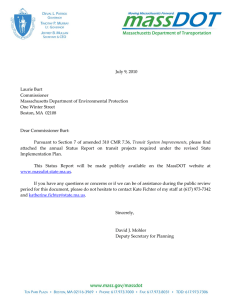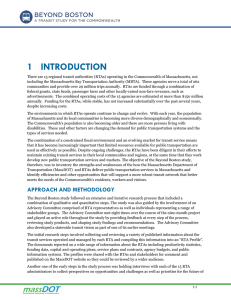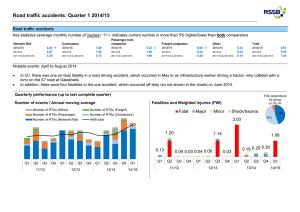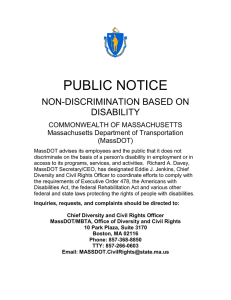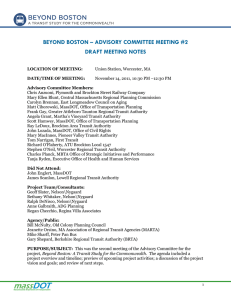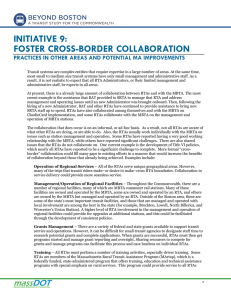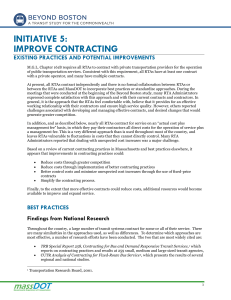BEYOND BOSTON – ADVISORY COMMITTEE MEETING #6 MEETING NOTES DRAFT
advertisement
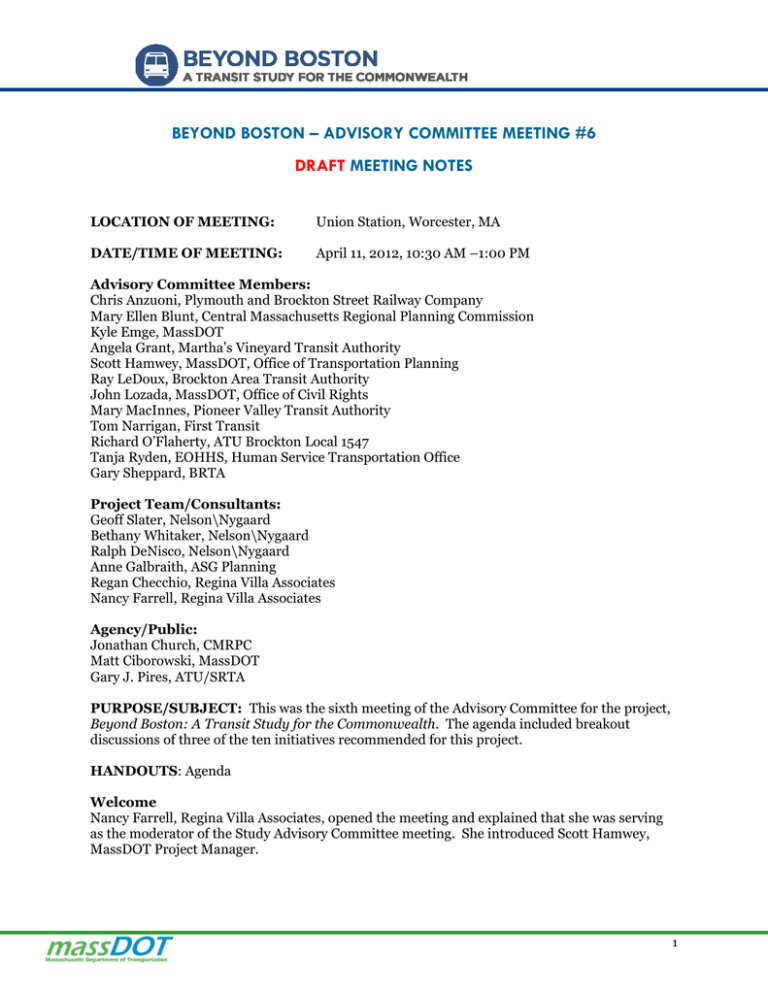
BEYOND BOSTON – ADVISORY COMMITTEE MEETING #6 DRAFT MEETING NOTES LOCATION OF MEETING: Union Station, Worcester, MA DATE/TIME OF MEETING: April 11, 2012, 10:30 AM –1:00 PM Advisory Committee Members: Chris Anzuoni, Plymouth and Brockton Street Railway Company Mary Ellen Blunt, Central Massachusetts Regional Planning Commission Kyle Emge, MassDOT Angela Grant, Martha’s Vineyard Transit Authority Scott Hamwey, MassDOT, Office of Transportation Planning Ray LeDoux, Brockton Area Transit Authority John Lozada, MassDOT, Office of Civil Rights Mary MacInnes, Pioneer Valley Transit Authority Tom Narrigan, First Transit Richard O’Flaherty, ATU Brockton Local 1547 Tanja Ryden, EOHHS, Human Service Transportation Office Gary Sheppard, BRTA Project Team/Consultants: Geoff Slater, Nelson\Nygaard Bethany Whitaker, Nelson\Nygaard Ralph DeNisco, Nelson\Nygaard Anne Galbraith, ASG Planning Regan Checchio, Regina Villa Associates Nancy Farrell, Regina Villa Associates Agency/Public: Jonathan Church, CMRPC Matt Ciborowski, MassDOT Gary J. Pires, ATU/SRTA PURPOSE/SUBJECT: This was the sixth meeting of the Advisory Committee for the project, Beyond Boston: A Transit Study for the Commonwealth. The agenda included breakout discussions of three of the ten initiatives recommended for this project. HANDOUTS: Agenda Welcome Nancy Farrell, Regina Villa Associates, opened the meeting and explained that she was serving as the moderator of the Study Advisory Committee meeting. She introduced Scott Hamwey, MassDOT Project Manager. 1 Mr. Hamwey said the meeting would consist of review and discussion of three of the Beyond Boston initiatives in the same breakout format that was used at the last meeting. Initiative 5: Improve Contracting Initiative 7: Additional Funding Initiative 8: Improve Funding Processes Mr. Hamwey gave a brief presentation. He showed the project timeline. He thanked the Advisory Committee for reviewing the documents in advance of the meeting and providing feedback on a conference call with all the RTAs. The documents sent out on Monday were revised based on comments received. Mr. Hamwey reviewed the initiatives to be discussed and the issues, potential solutions, best practices and outcomes associated with each. Breakout Groups on Initiatives Ms. Farrell described the format for the breakout groups; the members were pre-assigned with a facilitator. Other participants were invited to sit in on the discussions. The groups would be allocated time to discuss each initiative and to report back. Facilitators would be responsible for reporting back for the breakout group. At the end of Ms. Farrell’s overview, the Advisory Group went to their assigned groups and participated in the discussion of the individual initiatives. A summary of the major and minor themes by initiative is provided at the end of these meeting notes. Public Comment There were no public comments. Next Steps Mr. Hamwey thanked all of the participants. He noted that MassDOT would accept comments on the draft documents until April 20. At this point, final versions will be posted on the project website. The next meeting will be on May 24, 2012. At this meeting, MassDOT and the Advisory Committee will discuss draft action plans. Mary MacInnes asked if the final meeting for the project will include remarks by Secretary Davey. Mr. Hamwey said he will make that request. Ray LeDoux thanked MassDOT for allowing more time in the breakout groups to discuss the initiatives. Breakout Groups on Initiatives Initiative 5: Improve Contracting The GREEN Group: Fixed-cost breeds customer unfriendly environments. HST-incentives shares cost savings with HST and brokers. Fixed cost could produce better work environment. Fixed-cost can result in worse maintenance. SAC Meeting #6 –April 11, 2012 | 2 Maybe create a pilot project on fixed-cost contracting? Is an RTA willing? Cost plus leads to unforeseen costs. Hire an expert (by MassDOT) to further examine RTA contracts and to answer outstanding questions. The YELLOW Group: Historic precedent- why do Massachusetts RTAs use cost plus fee, while fixed-price is more predominant nationally? o 13C agreements with unions offered limited incentive to change (most are management + fee because limited opportunity to change) o Required to employ current employees and honor agreements In other places – contracts are for specific routes or areas, not overall operation. More could be completed in house, if there was an opportunity for larger in house staff. This could allow for better local control and operations. Lines between RTA, union and contractor are unclear in terms of contract negotiations. Fixed fee versus cost plus management fee o Performance measures should be incorporated regardless. Recognize that these require management and oversight with limited staff. Third party oversight and field monitoring are potential answers as well. o Performance measures should be tied into ITS for case reporting. o Types of performance measures On-time performance Boardings/alighting ridership? Consistency Customer satisfaction Is there the potential to share benefits of reaching performance targets with union, not just the contractor? Why is there a difference in contracts between fixed route versus ADA? o Fixed route is more consistent. o Fixed route is tied to legacy and thus follow older model (cost + fee). o ADA has more contracting opportunities/flexibility, because it is newer and has different types of operations. RTA staff capability o Current structure requires contracting all services. o Much effort made just to manage contracts. o Added staff could reduce delay in using contractors/DOT/RTAs. o Functions such as marketing and planning could be completed in house with additional staff. Competition- is it growing? Needed? o There has been some movement locally. o Institutional knowledge is lost when contractors change. o The subsidiary stays intact regardless of change in management. o Changes to performance measures may invite added competition. The RED Group: TRB Report may be outdated as a source because it reflects a shrinking number of respondents. Demand response versus fixed route SAC Meeting #6 –April 11, 2012 | 3 o Demand response requires much oversight to minimize fraud. o Should there be the same contractor for both? Unit Cost approach (Fixed fee) o Approach makes it difficult to shift or expand service. o Requires strong contract oversight because of performance metrics. o Incentives may not be in line for things like maintenance and staffing levels. o Incentives could be included but penalties need enforcement and have an effect on price. o Approach may not be appropriate for certain types of RTAs with specialized service. Fixed Cost plus fee approach: o Contractor is an agent of the authority. o It is possible to add on some special services under unit cost bids. Competition o There are barriers within the industry. o Local providers may have better understanding and better reach into the community. o National providers may provide more economies of scale. o Different providers for different types of service? (fixed route versus demand response) Initiative 7: Additional Funding The GREEN Group: Legislature wants to control revenue collection, leaving little flexibility at the local level. Periodic fare increases would be a good policy. Encourage private foundation or other non-profit to subsidize low income riders? Sponsors? Community involvement/advocacy. Low income riders need to be considered. Subsidies for low-income riders could allow for fare increases. Consider establishing target levels for funding sources (e.g. X% federal, X% state, X% local). MassDOT could take the lead on employee pass programs. U-Pass o New service should be 100% funded. o MassDOT could help with public universities/colleges. o Good idea! Employer pass programs should also be encouraged. Business improvement districts could be used. The YELLOW Group: Change title to "Additional Revenue", not Additional Funding because really discussing how to grow revenue from operations not just dollars from federal and state agencies. Fares – can they be increased? o Difficult politically to increase, with no mechanism to revisit. o Could fare increases be tied to an indicator? o A consistent statewide approach would be helpful. Indexes possible for use o CPI SAC Meeting #6 –April 11, 2012 | 4 o Cost Drivers (Fuel, Labor, Insurance) o Median Income o Farebox Recovery? o Non-transit indicators may be better, easier to accept and more fair. MassDOT’s possible rules o Set fare floor o Time-based re-evaluation, e.g. every 3-5 years be required to revisit fare Paratransit fares o Service is more expensive to provide. o Raising fares is politically difficult, especially on paratransit populations. o A statewide policy directive could assist on raising fares. o MBTA raising fares helps as well. UPass – is this viable or promising? o Colleges have other pressures to deal with as well. o PVTA has done a good job with UPass. o RTAs must provide meaningful service for this type of arrangement. o Attract a younger demographic by getting college students. o Interoperability with other services (commuter rail) is really important and what students want. o Universities benefit from these types of arrangement– they need less parking – and should look at improved transit as part of overall university planning. o Programs are marketing tools to university and students. o Need to make a transit case to universities. o Some colleges are harder to serve (location) or are geographically isolated. o State could make it more difficult to add parking for universities without looking at transit. There should be a regulatory trigger, like through MEPA or the state university capital process. o RTAs could provide service under contracts. UPass Funding o Look at university financing and direct investment o Fees are difficult (harder to get agreement) Tripper service (High School students) o Service is common in larger cities, but no real record of how process varies by city in MA. o Some are funded by municipalities o Service drives ridership up, which helps other metrics. o RTAs should share information on agreements through MassDOT or some other source. Local option taxes are a non-starter. The RED Group: It is difficult to compare RTAs to the MBTA because one size does not fit all, and the systems and levels of services offered are very different. Is the overall goal more buses or more full buses? Fare Increases: o RTAs that have performed fare increases have used professional consultants and looked at factors such as peer comparisons and elasticity of demand (in both cases, demand exceeded projections). SAC Meeting #6 –April 11, 2012 | 5 One RTA administrator thought local factors such as the population and area served need to be considered before a fare increase. o RTAs are more flexible than the MBTA when it comes to fare increases; RTAs are based on what the market can bear. o In both cases, the fare increases were triggered by budgetary issues. o Politically, fare increases are easier to implement when not expanding service. (Existing riders feel they are paying for new riders otherwise.) o Recovery ratios are interesting to look at but it is difficult to impose this metric on RTAs since they are all so different. o Technology can help because it allows for a differentiated fare structure based on the service. Partnerships: o Interoperability with the MBTA system is very important. o It would be helpful if the Executive Branch or Governor worked with public universities. o Incentives to partner with private universities include interoperability and marketing. o Service hours are barriers when dealing with some universities. o Demonstrate that these agreements between RTAs and colleges are preferable to building expensive new garages. o Department of Public Welfare is a potential partner. There could be a transit pass element of their services. o Transit mitigation with private development could be part of the MEPA review process. Test pilot transit projects paid for by developers o Work with Economic Affairs to add transit funding as part of the business development model o Work with EOHED on Priority Development Areas and TOD districts o Initiative 8: Improve Funding Processes The GREEN Group: Existing Process: o What's good? It provides money! Toll credits fill gap o What's bad? No real process/predictability Process always changes Timing (but Working Group working on this) Equity versus MBTA Equity among RTAs No policy RTAs define equity differently Some RTAs have better access to other funds than others Funding in arrears What is "magic" solution? o Better communication – open and honest o Formulas? Accept that there will be winners and losers SAC Meeting #6 –April 11, 2012 | 6 Could formulas be good? Operations: yes, if held harmless Capital: probably not Measures o Performance o Demand/ridership o Income/Socio-economic characteristics? o Maybe not population? o Need mechanism to fund new services Include justification Separate pot o Different groupings of RTAs are good (3-4?) Capital o Need to address real needs not imaginary number o Needs-based process better than formula (with some minimum level?) o Collaborative process? How to figure out details? o Final decisions need to be made by MassDOT o Follow federal process for comments? o The YELLOW Group: Is there anything to like about the current process? o The only good story: There has been money but system is broken Operating: o Need for clarity in how moneys are distributed. o Move away from funding in arrears. o Local assessments should be available much sooner for use by RTAs. o Any changes could hold harmless to a certain dollar amount, perhaps even above current number. o Any agreement reached should be collaborative. Potential measures to determine operating allocation o Any discussion of this is partially a discussion of goals for what the transit system should be. o Should be defined in conjunction with measures for other initiatives. Transparency is a "Good Idea." MassDOT consistency is important and lacking. o Staffing changes have caused this inconsistency. o Lack of policy framework makes staffing changes even more pronounced. Discussion on a simple approach (NY) versus Complex (Need, Operations) These are both just ways to communicate your goals for transit. A good feature of the NY approach is that the Pot could expand. Capital assistance: (How could this process be improved?) o Staffing on both sides is critical. o Consistency in request and response reporting is missing. o Handbook for capital processes should be completed. Other revenue streams can be tapped, but it’s unclear. o Toll credits o Other grant programs o How can state assist RTAs in getting other funds? SAC Meeting #6 –April 11, 2012 | 7 Processing Needs planning to be tied into capital planning statewide and by RTA Start with defining capital funding process before operating. The RED Group: Baseline amount of funding (enough for service desired?). Operations: o MassDOT must grade all RTAs on their planning process (look at collaborations) –on a simple Pass/Fail basis. o Formula could use 5307 as a starting point (similar elements, with different emphasis). o 5307 funds do not place enough emphasis on ridership and passenger miles. o How do you calculate population? Should it include demographic characteristics (% transit dependent, % EJ, % minorities, income)? The formula needs to account for areas with seasonal and college populations differently. o Disagreement over how heavily to weight population density; some found it most important o Ridership less important than population and population density; more important than route miles o Is need a factor in funding? How do you define need? o Performance needs to be accounted for, but could be triggered after the new formulas are in place. o Any factors used need to be carefully defined. (e.g. How is population defined? Does it include student population?) o State needs to set goals and define needs, then make sure new formula helps support state vision for transit. (Serve transit dependent populations? Reduce auto use? Etc.) Transition to a new State Contract Assistance formula from the historical one: o Long transition – timeframe may depend on the impact of the new formula (longer timeframe if a large impact) Need to determine the impact (in terms of SCA dollars) on any draft formula. Impact can also be calculated in terms of service. Local communities need to know if assessments will go up with any potential increase in SCA. o Hold harmless for a period of time. Capital: o A statewide inventory needs to be developed (could be done in 90 days) to examine current and future needs o Baseline level of funding to achieve "state of good repair" plus a wishlist should additional funding become available. o The Legislature needs to become part of these discussions in anticipation of the 2014 Transportation Bond Bill. SAC Meeting #6 –April 11, 2012 | 8
